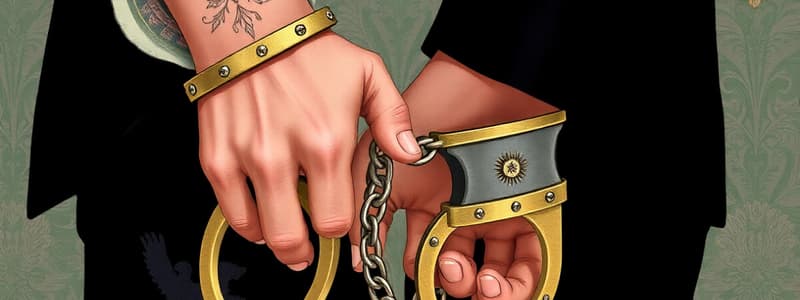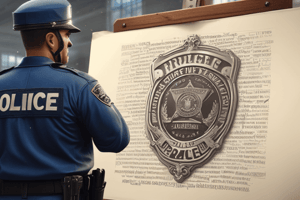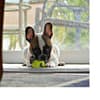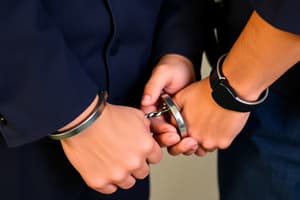Podcast
Questions and Answers
What should not be used as a cutting instrument for removing flexible cuffs?
What should not be used as a cutting instrument for removing flexible cuffs?
- Box cutter (correct)
- Wire cutters
- Surgical knife
- Scissors
Which step is crucial when applying flexible leg restraints?
Which step is crucial when applying flexible leg restraints?
- Verbal commands must be loud and clear. (correct)
- Restraining only one leg at a time.
- Applying restraints while standing.
- Using silent hand gestures.
What is the ideal position for the subject's legs when securing them with flexible restraints?
What is the ideal position for the subject's legs when securing them with flexible restraints?
- Bent at a 90-degree angle behind the body. (correct)
- Tucked under the body.
- Crossed over each other.
- Straightened out in front.
What should be ensured about the tightness of flexible leg restraints?
What should be ensured about the tightness of flexible leg restraints?
When should the flexible cuffs be disposed of?
When should the flexible cuffs be disposed of?
What is the first step in the handcuffing technique?
What is the first step in the handcuffing technique?
When preparing to remove handcuffs, what is the first action you should take?
When preparing to remove handcuffs, what is the first action you should take?
Which step comes after placing the first handcuff on a wrist during handcuffing?
Which step comes after placing the first handcuff on a wrist during handcuffing?
What should you do if a weapon has been drawn before approaching a subject?
What should you do if a weapon has been drawn before approaching a subject?
What should be done after applying handcuffs to ensure safety?
What should be done after applying handcuffs to ensure safety?
In which position can handcuffing techniques be applied?
In which position can handcuffing techniques be applied?
What is the purpose of waist chains?
What is the purpose of waist chains?
What is critical to establish when applying waist chains?
What is critical to establish when applying waist chains?
What is the primary purpose of restraint devices?
What is the primary purpose of restraint devices?
What precaution should officers take while applying handcuffs?
What precaution should officers take while applying handcuffs?
Which technique is important for controlling a subject during handcuffing?
Which technique is important for controlling a subject during handcuffing?
What should officers avoid when placing their knee across the subject’s shoulder?
What should officers avoid when placing their knee across the subject’s shoulder?
During the handcuffing procedure, when should verbal commands be given?
During the handcuffing procedure, when should verbal commands be given?
What position should your knees be in while maintaining a three-point pin on a subject?
What position should your knees be in while maintaining a three-point pin on a subject?
How should handcuffs be maintained for effective use?
How should handcuffs be maintained for effective use?
What is a key characteristic of the handcuffing technique?
What is a key characteristic of the handcuffing technique?
What is the initial distance the subject's hands should be from their body when applying handcuffs?
What is the initial distance the subject's hands should be from their body when applying handcuffs?
What should be checked for proper fit after applying handcuffs?
What should be checked for proper fit after applying handcuffs?
Which command should be used consistently while applying leg restraints?
Which command should be used consistently while applying leg restraints?
What position should the subject be in to maintain balance while applying leg restraints?
What position should the subject be in to maintain balance while applying leg restraints?
What type of restraints are flexible cuffs mainly used for?
What type of restraints are flexible cuffs mainly used for?
How should flexible cuffs be tightened during application?
How should flexible cuffs be tightened during application?
What common issue should be avoided when applying flexible cuffs?
What common issue should be avoided when applying flexible cuffs?
What is the purpose of using a padlock in the waist chain application process?
What is the purpose of using a padlock in the waist chain application process?
Flashcards
Restraint Devices
Restraint Devices
Tools used to temporarily restrict a person's movement.
Handcuffs
Handcuffs
A common restraint device used to control a person.
Officer Safety
Officer Safety
Handcuffing doesn't make a subject harmless; constant monitoring is needed.
Reactionary Gap
Reactionary Gap
Signup and view all the flashcards
Three-Point Pin
Three-Point Pin
Signup and view all the flashcards
Verbal Commands
Verbal Commands
Signup and view all the flashcards
Subject Arm Control
Subject Arm Control
Signup and view all the flashcards
Maintain Control
Maintain Control
Signup and view all the flashcards
Handcuffing Technique Steps
Handcuffing Technique Steps
Signup and view all the flashcards
Handcuff Removal Steps
Handcuff Removal Steps
Signup and view all the flashcards
Waist Chains
Waist Chains
Signup and view all the flashcards
Verbal Commands
Verbal Commands
Signup and view all the flashcards
Subject Positioning
Subject Positioning
Signup and view all the flashcards
Non-compliant Subjects
Non-compliant Subjects
Signup and view all the flashcards
Weapon Management
Weapon Management
Signup and view all the flashcards
Appropriate Positions
Appropriate Positions
Signup and view all the flashcards
Handcuff Application
Handcuff Application
Signup and view all the flashcards
Waist Chain Application
Waist Chain Application
Signup and view all the flashcards
Leg Restraint Application
Leg Restraint Application
Signup and view all the flashcards
Leg Restraint Positioning
Leg Restraint Positioning
Signup and view all the flashcards
Verbal Commands
Verbal Commands
Signup and view all the flashcards
Flexible Cuffs
Flexible Cuffs
Signup and view all the flashcards
Flexible Leg Restraints
Flexible Leg Restraints
Signup and view all the flashcards
Blood Circulation Check
Blood Circulation Check
Signup and view all the flashcards
Removing flexible cuffs
Removing flexible cuffs
Signup and view all the flashcards
Applying flexible leg restraints
Applying flexible leg restraints
Signup and view all the flashcards
Subject Control (upper body)
Subject Control (upper body)
Signup and view all the flashcards
Leg Restraint Placement
Leg Restraint Placement
Signup and view all the flashcards
Tightening Restraints
Tightening Restraints
Signup and view all the flashcards
Study Notes
Restraint Devices
- Restraint devices temporarily restrain a subject's movements.
- Examples include handcuffs, waist chains, leg restraints (leg irons), and flexible leg restraints.
- Handcuffs are frequently used for temporary subject control.
- Continuous monitoring is essential when using handcuffs to ensure officer safety.
- Handcuffing procedures should be performed in a controlled manner to minimize harm to both the officer and the subject.
Handcuffs
- Handcuffs are temporary restraint devices used for subject control.
- Handcuffing does not render a subject harmless.
- Subjects should be continuously monitored after handcuffing.
- Officers should prepare to respond appropriately if the subject resists.
- The procedure should be controlled to minimize potential harm.
- Identify handcuff parts using diagrams (e.g., Figure 4-24).
Three-Point Pin
- A three-point pin is a control technique used for handcuffing.
- Use loud verbal commands during application.
- Control the subject's right arm and wrist. Place the right knee across the subject's right shoulder blade (avoiding spinal cord pressure) and the left knee on the ground close to the rib area.
- Maintain posture to allow quick recovery.
Handcuffing Technique
- Handcuffing techniques vary based on subject compliance levels.
- Essential steps include verbal commands, subject positioning, weapon management (if applicable), holstering/draw, handcuff placement (one at a time), proper fit check, and double locking.
- The technique can be used in various positions (standing, kneeling, prone).
- Non-compliant subjects require specific control techniques.
Removing Handcuffs
- Steps for removing handcuffs include loud verbal commands, subject positioning, drawing the handcuff key, removing one cuff, controlling the uncuffed hand, and removing the second cuff.
- Move away from the subject after removing the cuffs.
Waist Chains
- Waist chains are used to secure a subject during transport.
- Apply verbal instructions, position the subject with hands in front, and fasten the waist chain using a black box anchor and chain.
- Secure the chain to the subject.
Leg Restraints
- Leg restraints (leg irons) are often used with waist chains to restrict movement.
- Apply verbal instructions, ensure proper positioning to prevent injuries, and secure the restraints with a double lock.
Flexible Restraints
- Flexible cuffs and flexible leg restraints are lightweight tools for multiple subjects.
- Cuffs can be single or double, wrapped around wrists and fastened.
- Leg restraints secure ankles.
- Use caution when using cutting instruments to remove cuffs.
Studying That Suits You
Use AI to generate personalized quizzes and flashcards to suit your learning preferences.
Related Documents
Description
Explore the principles and procedures related to restraint devices, focusing on handcuffs and techniques like the three-point pin. Gain insights into safety measures and the importance of continuous monitoring during restraint. Understand the proper usage and control necessary to minimize harm to both officers and subjects.



